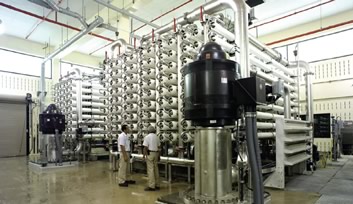Glades Road Water Treatment Plant Membrane Softening Process Addition, BOCA RATON, FL

VALUE DELIVERED
A new, more effective water treatment process; regulatory compliance; effective coordination of a complex project with multiple subcontractors and suppliers; non-disruptive operation of current facility; significant reduction in operating expenses; lower energy costs; project tasks performed in spite of constrained conditions; a safer environment for plant personnel and the surrounding community; increased customer satisfaction with water quality; professional recognition of the project’s success.
CLIENT OBJECTIVES
To improve water quality and comply with new regulations.
SCOPE OF SERVICES
This plant – Boca Raton’s primary water supply – uses raw water from the Biscayne Aquifer, which is high in organic content, color and hardness. Prior to this project, the plant used a conventional lime softening treatment process. This process only marginally met the new, more stringent requirements of the Disinfectant/Disinfection By-Product Rule (D/DBPR) under the Safe Drinking Water Act. In addition, there was considerable customer dissatisfaction with the color of the water. To ensure regulatory compliance and address customer complaints, the city elected to add a 40-mgd (million gallons per day) nanofiltration process in which membrane permeate could be blended with the existing lime-softened water supply. To implement this, the city awarded the plant construction contract to Poole & Kent. The contract included all construction, contract coordination, startup and performance testing.
The major project components included:
- Six stainless steel constant-speed horizontal split-case raw-water booster pumps housed in the pump building
- A multimedia pre-treatment pressure filter system with eight independent filter cells
- 12 stainless steel five-micron cartridge filters
- Ten 3.676-mgd stage 1 and 2 membrane units with dedicated variable-speed vertical-turbine membrane feed pumps
- Two 1.62-mgd convertible membrane units with dedicated variable-speed vertical-turbine membrane feed pumps. These units can be operated as either two-stage 85-percent recovery units using raw feedwater from the well field, or as third-stage "concentrator" units, operating at 50-percent recovery, using concentrate from the other 10 membrane units as feedwater.
- Two independent membrane cleaning systems
- A permeate flush system to displace the feedwater in the membrane unit with permeate when the unit shuts down. The cartridge filters, membrane units, control room, electrical equipment, and membrane cleaning and flushing system are housed in the process building
- Sulfuric acid, anti-scalant, and caustic bulk storage and feed systems
- Six 6.67-mgd forced-draft, packed-tower degasifiers located over the existing filterbuilding clear well. The internals of one bank of the lime-softening process’s existing sand filters were removed, and two degasifiers were installed in each of three filter bays.
- Two packed-tower odor control scrubbers to remove hydrogen sulfide gas from gasses emitted by the degasifier
- Three new 15,000-gpm (gallons per minute) vertical turbine finished water transfer pumps installed over the existing clear well to transfer the disinfected, post-treated finished membrane permeate to the on-site finished water storage tanks
- One 1,000-hp (horsepower) and one 600-hp dual drive (electric motor and diesel engine) horizontal split-case high-service pumps in a new high-service pump building
- Three new 1,500-kW diesel-engine-driven backup power generators to provide power to the membrane process equipment in the event of an outage
- Miscellaneous site work and yard piping, as well as installation of electrical instrumentation and controls as necessary to integrate the new membrane process into the existing lime softening treatment plant.
Since going into full-scale operation, the plant has been a dramatic success. The first large plant of its type to operate without chemical pre-treatment, it is saving the city nearly $1 million per year in operating costs. This does not include indirect cost savings associated with operation and maintenance of the chemical storage and feed systems, training, cleaning, etc. In addition, by eliminating chemical pre-treatment, the project also eliminated a substantial source of day-to-day safety risk to the operations staff and the surrounding community. Furthermore, the low-fouling membranes are currently operating at lowerthan- specified pressures, saving the city nearly $50,000 per year in power costs. Finally, all water quality goals are being met, and the city utility staff has received numerous compliments from customers regarding the noticeable improvement in the water’s aesthetic quality. The project won the 2006 Florida Institute of Consulting Engineers (FICE) Grand Award for Engineering Excellence in Water and Wastewater.
SOLUTIONS
In completing this project, Poole & Kent successfully overcame several challenging situations:
- Since this project constituted a major modification to the existing plant, close coordination between the contractor and plant operations was required to incorporate the new facility into the existing plant, while minimizing disruptions and maintaining an uninterrupted water supply for Boca Raton's citizens.
- The existing plant site was very constrained, requiring an extremely compact process layout, as well as extraordinary care to protect existing facilities from damage during construction activities.
- To keep the project on schedule, construction administrators had to carefully coordinate multiple subcontractors and multiple suppliers.
- To take advantage of the new low-fouling membrane technology developed for this project, the city purchased the membrane elements directly from the supplier and provided them to the general contractor for installation. This necessitated detailed scheduling and contractual coordination of the membrane element manufacturer, the membrane system supplier, the instrument system supplier, and the general contractor.
BACKGROUND
When commissioned, the plant became the largest nanofiltration plant in the world.





